 Research Article
Research Article
Comparison of Dentin Debris Extrusion After the Use of WaveOne Gold and Procodile Q NiTi File
Ana Stephanie Mayoral Beltran, Fauzia Dadarkar and David E Jaramillo*
Department of Endodontics, University of Texas Health Science Center at Houston, USA.
David E Jaramillo, Department of Endodontics, University of Texas Health Science Center at Houston, USA.
Received Date: June 15, 2022; Published Date: July 27, 2022
Introduction
The goal of root canal treatment is to prevent and treat apical periodontitis, by eliminating inflamed pulp tissue as well as microorganism and necrotic pulp tissue by chemomechanical debridement and providing a good quality root canal filling. According to Sjögren, et al. [1] the success rate of root canal treatment goes as high as 96% in teeth without periapical lesions. Salehrabi, Rotstein [2] metanalyses, found a 97% retention rate of root canal treated teeth while Hannahan, Eleazer [3] showed no statistical difference in the success rate between single implants and teeth with non-surgical root canal treatments. The root canal instrumentation is perform using different type of hand files or mechanical driven rotary or reciprocation instruments. However, during root canal instrumentation dentin debris, pulp tissue, and bacteria are likely to get extruded through the apical foramen. This extrusion might be responsible for the presence of severe postoperative pain and/or swelling [4].
The design of the file is important to prevent the extrusion of the debris during the cleaning and shaping phase. The amount of extruded debris was first measured using a model invented by Myers and Montgomery [5]; showing that there is a close relationship between the instrument, the technique used and the quantity of debris extruded through the apex. Balanced force technique has demonstrated least extrusion when compared to linear filing motion [6].
Procodile Q (Komet, USA) is a standard nickel titanium (NiTi) file with a positive rake angles that maximizes efficiency and flexibility, and additionally is heat treated pre-grinding; since post production treatments dulls the cutting capacity of files. The system combines a variably tapered core with controlled memory for unrivaled flexibility for a safer and more efficient root canal preparation and performance, with a unique design to resist cyclic and torsional fatigue and to prevent debris extrusion.
The system offers three different sequences for narrow, medium, and wide canals with taper .06, .05 and .04 respectively. The narrow sequence consists of three files with taper .06 and tip size 20, 25 and 30. The sequence for medium canals is comprised of two files taper .05 with a tip size of 35 and 40, and lastly the wide canal sequence includes two files with a taper .04 and a tip size of 45 and 50. To determine the canal size the manufacturer suggests to slowly introduce a file iso #15 to working length and if the file meets resistance, then the canal is considered narrow in size, on the other hand if the file meets little or no resistance the canal is “medium” or “large”.
The new trend is to reduce the chair time while improving the efficiency of the root canal treatments, thus manufacturers are fabricating and proposing single file systems to meet the needs. Different types of alloys make instrument characteristics different than conventional nickel titanium files. A new M-wire NiTi in endodontics instruments provides instruments with more flexibility and fatigue resistance. WaveOne Gold (Denstply Tulsa, OK) has been one of the most utilized M-wire single file system used by practitioners.
WaveOne Gold is a reciprocating system that runs at 10 cycles per second with a 360° rotation every three reciprocating motions. Four files are available to fit different canal sizes, the Small file is a tip size #20 with .07 taper, the Primary file offers a tip size #25 and a .07 taper, the Medium file has a tip size #35 and .06 taper, and the Large file is equivalent to a #45 tip size with .05 taper.
The Step Back Technique, is a technique that allows to produce a continuous taper from the orifice entrance to the apex of the canal. The procedure was introduced in 1964 by Clem [7], and is made in two stages. Stage one grants the preparation of an apical constriction at the end of the canal, meanwhile on stage two, by increasing the file size and gradually stepping back we produce a sustained taper which will facilitate the obturation process.
Since there have been other studies evaluating the degree of debris extrusion of different file systems, we wanted to measure the amount of dentinal debris extruded through the apical foramen by the Procodile Q system since is a system that is new to the market and there are no studies about this particular file.
Materials and Methods
The protocol was approved by the Ethics Committee for the Protection of Human Subjects of the University of Texas Health Science Center School of Dentistry at Houston (protocol no. HSCDB- 22-0174).
Freshly extracted mandibular incisors were collected from urgent care and periodontal clinic and stored in a 5% thymol solution until use. Teeth were subjected to multiple angled radiographs to confirm the presence of a single canal, no evidence of calcifications or previously treated. Root curvature was measured following the Schneider [8] method and teeth with a curvature of <5˚ were selected for the study. A total of 60 freshly extracted human mandibular incisors with mature apices, straight root canal and single root canal, were selected for the study.
Elected teeth were standardized using a diamond disc to a length of 16mm going from the incisal edge to the apices of the root end.
The debris were collected and measured using a modified Myers and Montgomery model [5], that consisted of an Eppendorf micro test tube and a second Scintillation vial. Two perforations were drill to Eppendorf micro test tubes caps, a small orifice that served as a released for the build-up pressure, and a bigger one that held the teeth in position for instrumentation. Then the micro test tubes were weighted two times in an electronic scale to obtain a mean initial weight and the results were recorded. A Scintillation vial was used to hold the Eppendorf microtube in place.
Each tooth granted coronal access using a round #2 carbide bur, then apical patency was established by inserting a # 10 K-file from the access opening to the apical terminus, thus confirming permeability of the canal and working length. The total number of samples (n=60) was divided into four subgroups of 15 teeth each (n=15) and instrumented with a different shaping technique. Every tooth was mounted in the modified Montgomery model and a dental dam was used to hide the apex of the root from the operator. Instrumentation was done following manufacturer instructions and apical patency was preserved using a #8 K-File past of the working length.
Step back group
The first phase of the canal preparation was done using hand files from #15 through #40 at the predetermined working length (16mm). In between files; one mL of distilled water was used as irrigation solution and a #08 K-file was employed to keep patency at the apex. A hand file #40 was standardized as the master apical file for each sample. In the second phase of the shaping process, the continuous tapper was created by incrementing the size file and stepping back progressively.
WaveOne gold group
The first file utilized for the WaveOne Gold group was the Small file (##20/.07) using a pecking motion with light apical pressure (following manufacturer recommendations) until reaching working length. Once working length was reached, apical patency was corroborated with a #8 K-File passing working length measurements and one mL of distilled water was used as an irrigation agent. This procedure was repeated with the Primary and Medium files.
Procodile Q group
After utilizing a #15/.02 hand file as a path glide, the Narrow Procodile Q sequence consisting of a #20/.06 file was used until getting to working length. One mL of distilled water was used as irrigation solution and a #8 K flexo file was used to keep the patency of the apical foramen. Then the following files of the Narrow series were used (# 25/.06, # 30/.06) in the same manner process until working length was reached.
Procodile Q crown down group
The Medium #35/.05 Procodile Q file was directed apically with an “in-and-out” pecking motion with an amplitude of approximately 3mm using light apical pressure (as recommended by the manufacturer). Once the file presented resistance, the instrument was removed from the tooth and one mL of water was used to irrigate the root canal. Followed by the #30/.06, # 25/.06 and # 20/.06. This protocol will be repeated continuously until the working length was reached.

After instrumentation was done, the collected liquid and solid debris were placed and stored in a incubator at 37°C for a period of five days to permit the water remnants to evaporate, thus the Eppendorf micro test tubes were left with the solid debris. The extruded debris were weighted three times in a electronic scale (Sartorius Cubis, Gottingen, Germany) with an accuracy of ±0.00001 g. A mean post-operatory weight was obtain and compared with the pre-operatory weight (Figure 1).
Results
The dentinal debris extrusion was recorded for all four groups. There is statistical difference in between step back technique compared to Procodile Q (Crown Down) and WaveOne Gold systems (p<0.05). The highest mean extrusion value was produced by the Step Back technique. The mean value of pre and post extrusion by all the four groups are given in the following (chart/Table 1). All analyses were performed using R statistical software (R Core Team 2018). R Core Team (2018). R: A language and environment for statistical computing. R Foundation for Statistical Computing, Vienna, Austria. URL https://www.R-project.org/ [9] (Tables 1, 2).
Table 1: Pre and post weight of debris collection.
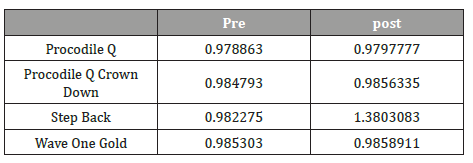
Table 2: Pre-weight and post instrumentation weight of extruded debris.

Observational findings of reciprocation systems
During the root canal instrumentation various important files features were observed.
Procodile system was faster in reaching working length on both modalities when compared to WaveOne Gold. It was also observed more debris coronally extruded during instrumentation and good amount of debris attached to the file. As well, flexibility of Procodile file is by far, higher than the one observed in WaveOne Gold files (Tables 3-5) (Figures 2, 3).
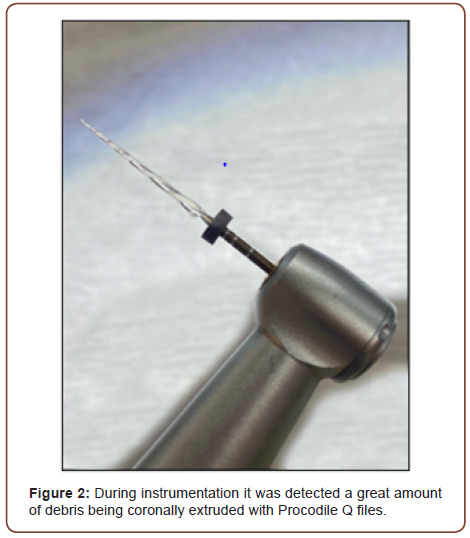
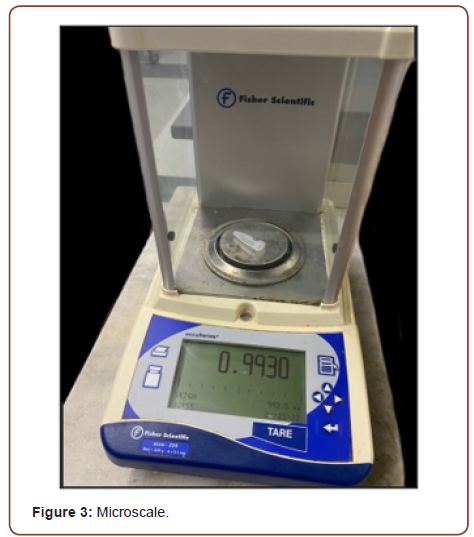
Table 2: Procodile sequence. Strokes necessary for each file to reach working length.
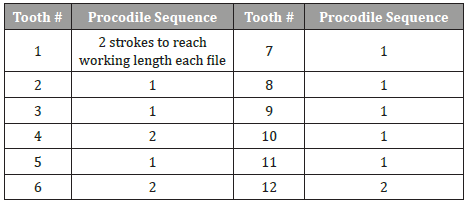
Table 2: Procodile Crown Down. Strokes necessary for each file to reach working length.
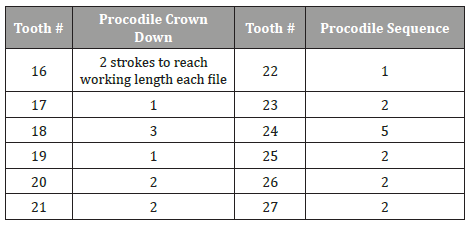
Table 2: WaveOne Gold. Strokes necessary for each file to reach working length.
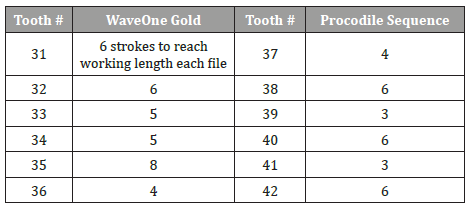
Discussion
Our results confirmed, the extrusion of debris through the apical foramen happens regardless of the instrumentation technique or system used for the debridement of the root canal space [5]. As expected, the Step back technique extruded more debris out of the four groups (p<0.05) and this finding is similar to other studies [10- 12]. The high R-Squared value for the Step back group, supports to the technique having a strong effect in the amount of debris extrusion. We attributed this outcome to the type of instrument, since in the initial phase of the Step back technique; the continuous .02 taper of the hand files and the close proximity of the flutes of the active portion of the file does not leave enough space to allow the debris to move coronally within the canal, additionally al- Omari, Dummer [6], concludes that the filling motion of the Step back technique pushes the debris apically. Even though the rest of the groups extruded debris through the apical foramen, it was of no statistical significance (p>0.05). There has been a change of WaveOne Gold technique since the last report done by Jaramillo (2015) [10]. WaveOne Gold has change its instrumentation technique by adding the peaking motion and constant irrigation, to help remove most of the produced debris and to prevent the pack down of dentin debris by a single direct apical pressure motion of the instrument. While the new Procodile version, Procodile Q design and motion, produces more abundant coronal extrusion of debris as the instruments advances faster apically, plus the peaking motion recommended by the manufacturer. The newer technology in instrument design increases the efficacy to prevent in larger amount, the debris extrusion during the instrumentation phase of the root canal treatment.
The study has some limitations like the inability to recreate the back pressure from the apical tissues being this a contributing factor for the extrusion of debris regardless of the technique used [5]. Moreover, the study was limited to samples with straight canals, thus the observed results should not be generalized to teeth with curvatures in the root. Additionally, the engine driven instruments used a different type of motion, WaveOne Gold uses a reciprocating motion, while Procodile Q operate with a continuous rotatory motion [13]. For future projects it would be advised to compare similar modes of motions [14-16].
Conclusion
The differences in the amount of debris extruded may be explained by the technique used to prepare the root canal space, the use of reciprocating motion or by the design of the files. Procodile Q, Procodile Q Crown-Down sequence, and WaveOne Gold produce minimal debris extrusion while Step back produced most of the debris extrusion.
Acknowledgement
None.
Conflict of interest
No conflict of interest.
References
- Sjögren U, Hägglund B, Sundqvist G, Wing K (1990) Factors affecting the long-term results of endodontic treatment. J Endod 16(10): 498-504.
- Salehrabi R, Rotstein I (2004) Endodontic treatment outcomes in a large patient population in the USA: An epidemiological study. J Endod 30(12): 846-850.
- Hannahan JP, Eleazer PD (2008) Comparison of success of implants versus endodontically treated teeth. J Endod 34(11): 1302-1305.
- Bassam S, El-Ahmar R, Salloum S, Ayoub S (2021) Endodontic postoperative flare-up: An update. The Saudi Dental Journal 33(7): 386-394.
- Myers GL, Montgomery S (1991) A comparison of weights of debris extruded apically by conventional filing and Canal Master techniques. J Endod 17(6): 275-279.
- al-Omari MA, Dummer PM (1995) Canal blockage and debris extrusion with eight preparation techniques. J Endod 21(3): 154-158.
- Clem WH (1969) Endodontics: the adolescent patient. Dent Clin North Am 13(2): 482-493.
- Schneider SW (1971) A comparison of canal preparations in straight and curved root canals. Oral Surg Oral Med Oral Pathol 32(2): 271-275.
- Kharouf N, Pedullà E, Nehme W, Akarma K, Mercey A, et al. (2022) Apically extruded debris in curved root canals using a new reciprocating Single-File shaping system. J Endod 48(1): 117-122.
- Jaramillo DE, Aguilar E, Leon M, Aprecio R (2015) Comparison of the extrusion of dentin debris using a new instrumentation concept. Oral Health 28-32.
- Kustarci A, Akdemir N, Siso SH, Altunbas D (2008) Apical extrusion of intracanal debris using two engine driven and Step-Back instrumentation techniques: An In-Vitro study. Eur J Dent 02(04): 233-239.
- Jindal R, Singh S, Gupta S, Jindal P (2012) Comparative evaluation of apical extrusion of debris and irrigant with three rotary instruments using crown down technique-an in vitro study. J Oral Biol Craniofac Res 2(2): 105-109.
- Liang Y, Yue L (2022) Evolution and development: Engine-driven endodontic rotary nickel-titanium instruments. International Journal of Oral Science 14(1): 1-8.
- Varma KR, Singh P, Haridas K, Hariharan M, Varughese A, et al. (2019) Effect of instrumentation techniques and kinematics on apical extrusion of debris: An in vitro study. J Contemp Dent Pract 20(9): 1067-1070.
- Burklein S, Schafer E (2012) Apically extruded debris with reciprocating single-file and full-sequence rotary instrumentation systems. J Endod 38(6): 850-852.
- Schafer E, Vlassis M (2004) Comparative investigation of two rotary nickel-titanium instruments: ProTaper versus RaCe. Part 1. Shaping ability in simulated curved canals. Int Endod J 37(4): 229-248.
-
Ana Stephanie Mayoral Beltran, Fauzia Dadarkar, David E Jaramillo. Comparison of Dentin Debris Extrusion After the Use of WaveOne Gold and Procodile Q NiTi File. On J Dent & Oral Health. 6(1): 2022. OJDOH.MS.ID.000626. DOI: 10.33552/OJDOH.2022.06.000626.
-
Root canal, Teeth, Dentin debris, Pulp tissue, Endodontics instruments, Canal preparation, Root canal space, Dental dam, Step back technique, Tooth
-

This work is licensed under a Creative Commons Attribution-NonCommercial 4.0 International License.






